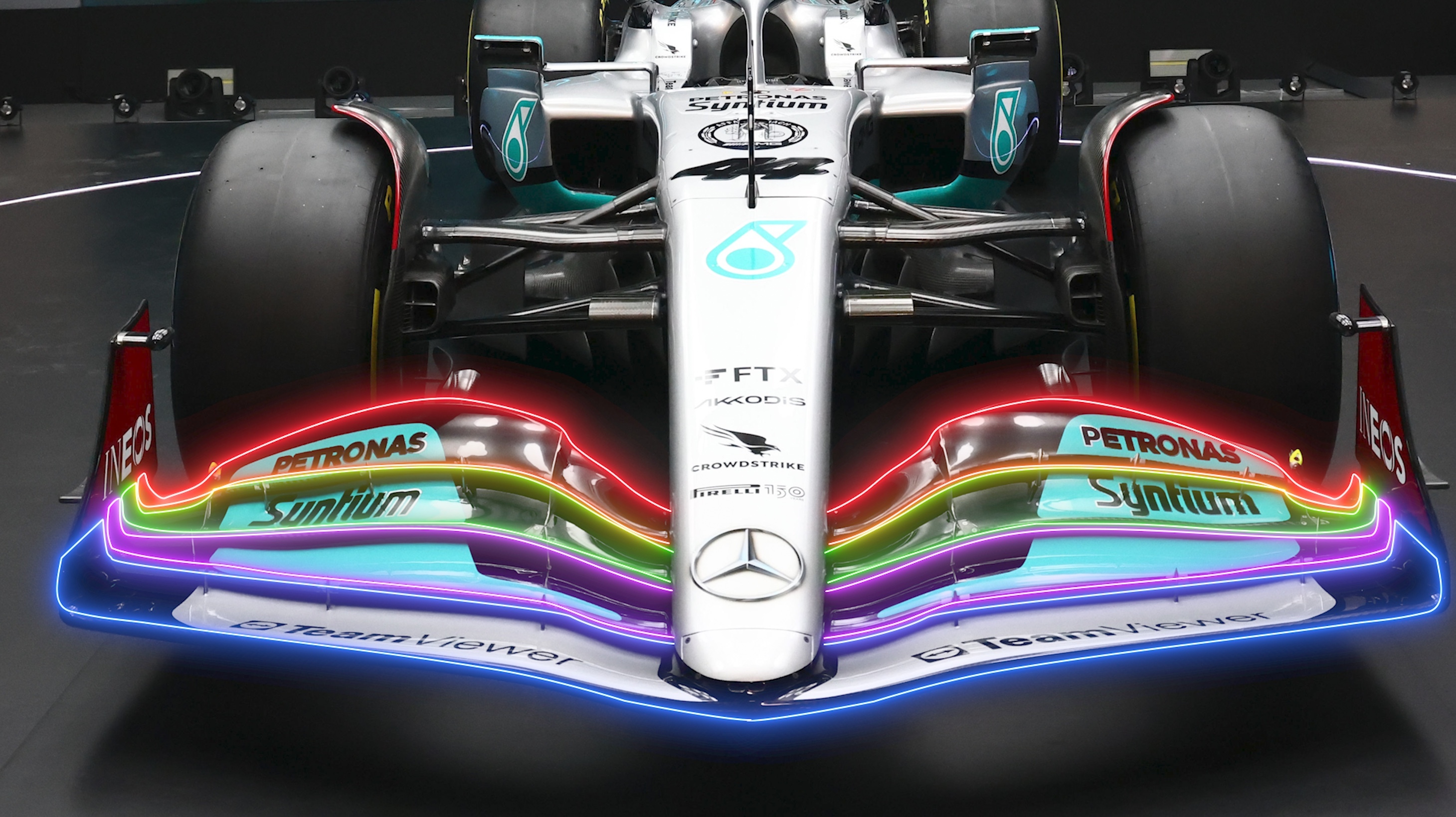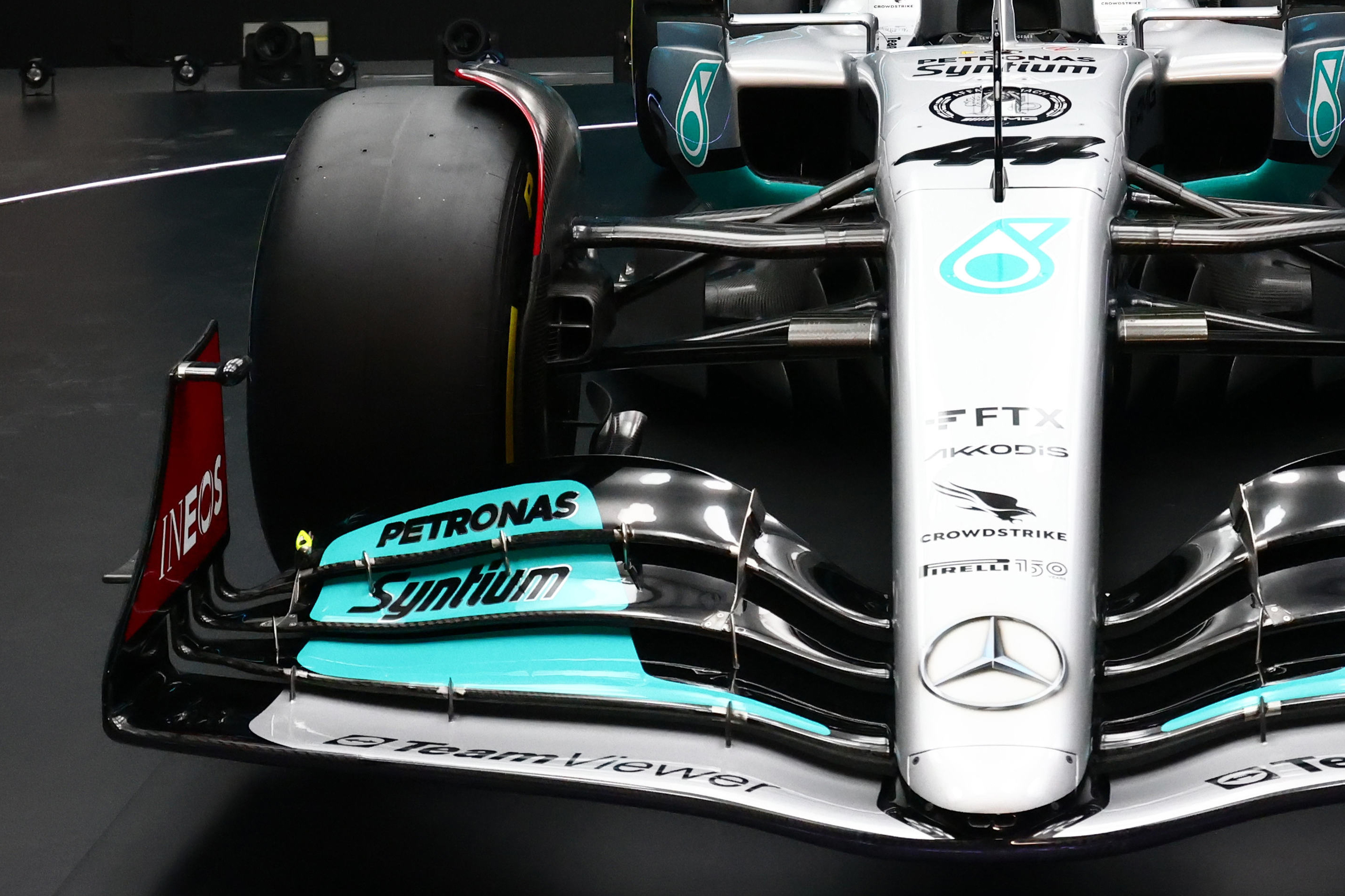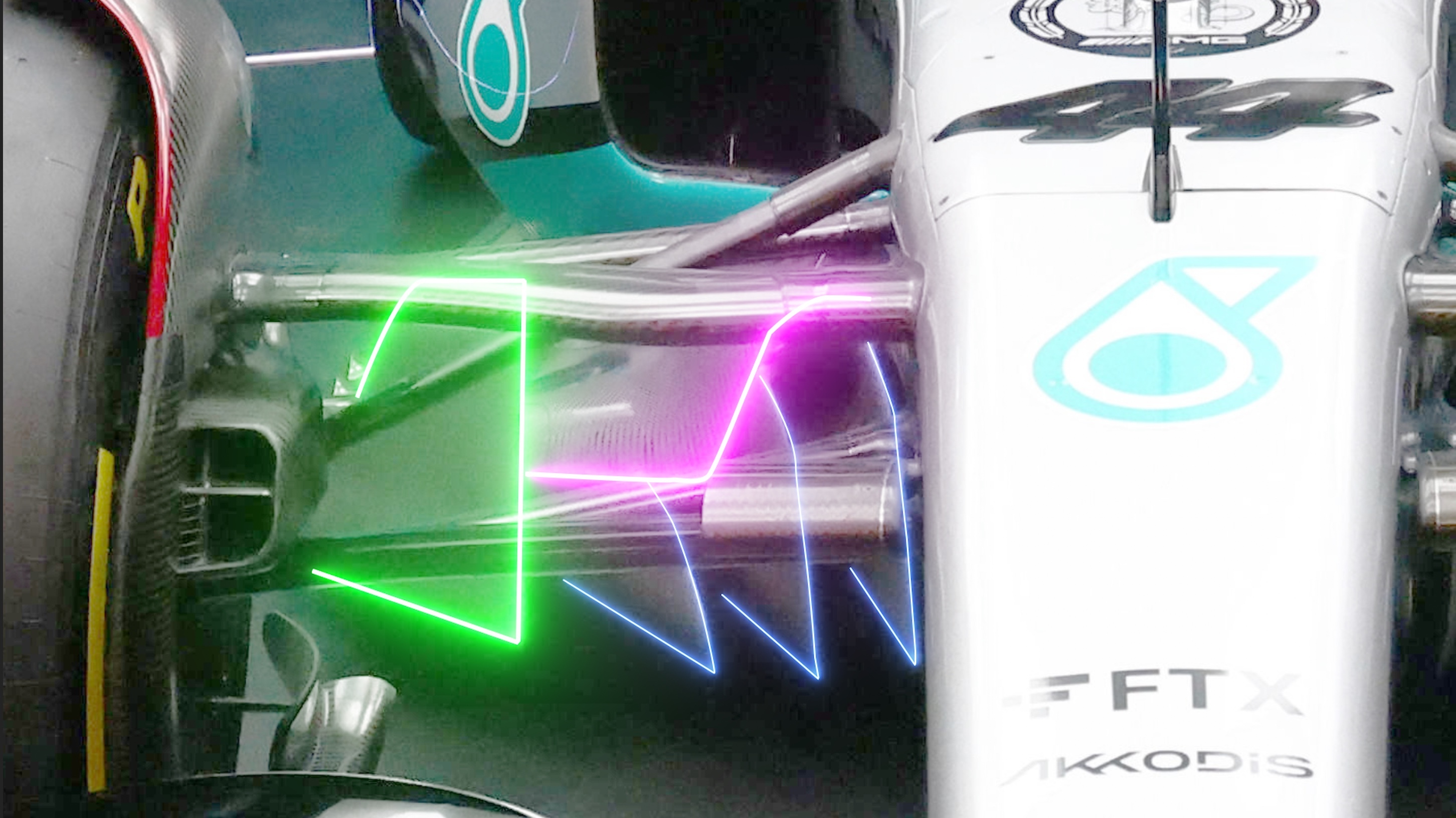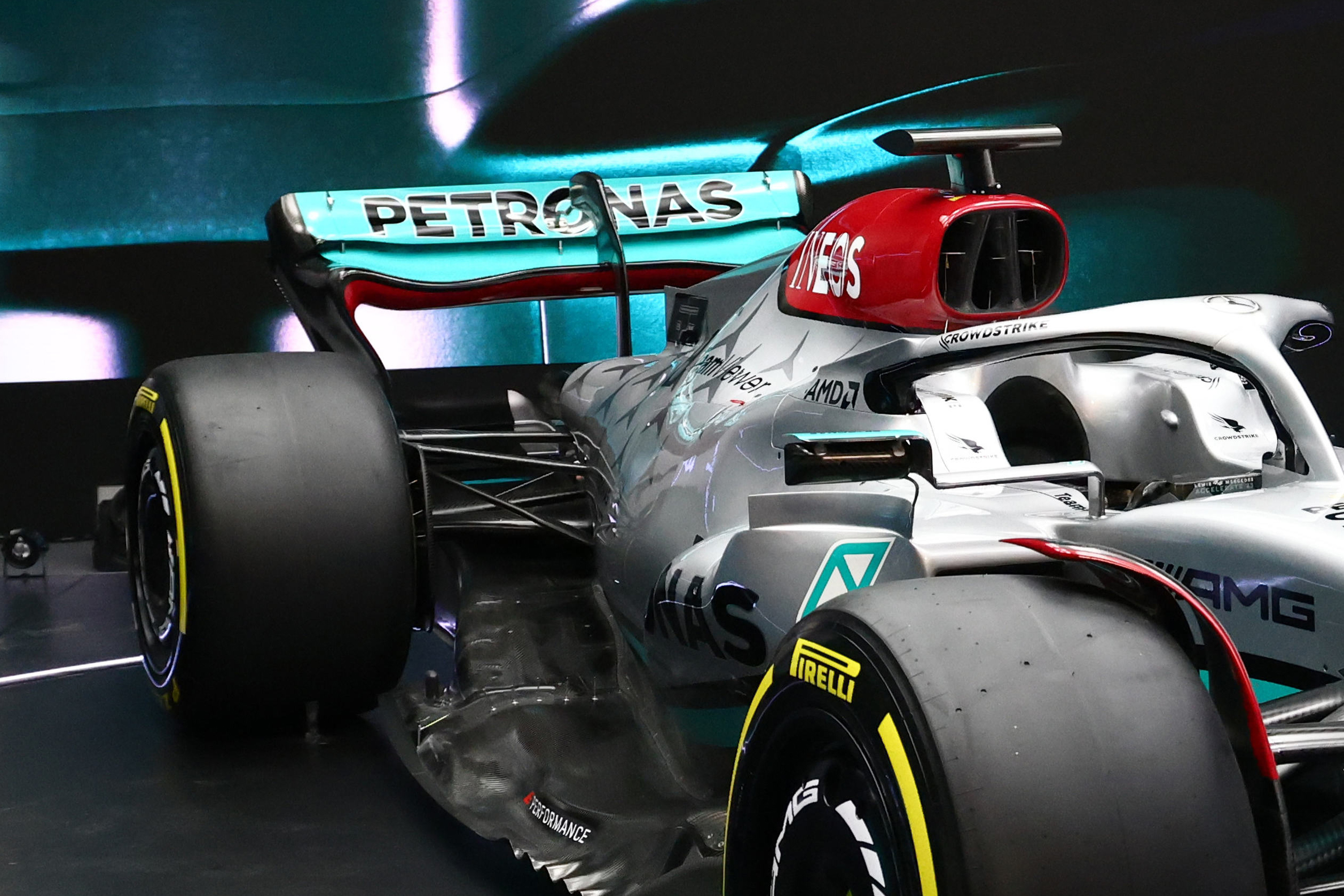Up Next

The fact Mercedes has won eight consecutive Formula 1 constructors’ championships shows that it knows how to design and research a given set of regulations and come up with the best package. That bodes well for the new Mercedes F1 W13.
Yes, this can be boring but it’s not the fault of Mercedes. All 10 teams have the same opportunity with these new rules, especially now with the budget control equalising the spending. But even before that it’s not just about money because no matter how much you have, you have to spend it wisely.
As I said on our podcast looking at the new Aston Martin last week, the bigger the budget the more the manpower and the bigger the skip out the back to put all the ideas that didn’t work in. The best example of this in the 21st century would be big-spending Toyota.
Mercedes, on the other hand, has always started the season competitively. It has needed to dig deep on a few occasions, but since 2014 Mercedes has got there and coped well with several regulation changes.
With these new regulations for 2022, it’s not just small changes because it’s all new. We all hope that some of the other teams can close the gap to whoever sets the standard to make it an even more competitive season.
But regardless of the changes, what drivers demand from the car is exactly the same as they wanted 20 years ago, so it’s important not to try to reinvent the wheel.
The renders that Mercedes produced were very different from the actual car that was in its live release but they were based on an earlier version of the design. So this analysis is based on the car used for the launch, which is also the same one that has been shaken down at Silverstone.
NOSE/FRONT WING

The front wing is, as with everyone else, a four-element component. The first/bottom element has a small spoon section in the middle. The chord length of this element is the longest.
This is vastly different to what we saw from Ferrari. The Mercedes front wing is not so highly loaded inboard, allowing less disturbed airflow to travel underneath the chassis into the leading edge of the underfloor.
It then loads up mid-span and diminishes towards the endplate, as is required in the regulations.
The rear element is adjustable over probably two thirds of its length. This will give a reasonable balance change for very little angle change.
The endplates curve out as they go upwards, similar to most other cars, to try to turn the airflow around the outside of the front tyre. This is very limited within the regulations to reduce the potential of outwash.
The first element mounts the wing to the nose with the other three elements emerging out from the side of the nose. Because of this, there is no slot gap between the first element and nose.
And the nose, although pointy, is nowhere as pointy as the Ferrari example.
FRONT SUSPENSION

This is a double wishbone with pushrod-operated internal suspension components.
In the past, the pushrod was driven from the upright to allow them to maximise the ride height change and load distribution with steering lock. This characteristic has been outlawed this year, so on the Mercedes W13 the pushrod is driven from the outer end of the bottom wishbone.
The steering trackrod is in line with, or part of, the forward leg of the top wishbone. A small change of section and angle can be seen about halfway along the length.
This will be to optimise the airflow coming off the trailing edge of the loaded part of the front wing flaps. You can’t do much with these suspension links but every little helps with consistency.
FRONT BRAKE DUCTS
The Mercedes brake ducts are larger than some, smaller than others – so are probably in the area that will be required for the larger-diameter brake discs.
The inner wheel fairing blends into the mudguard, but from these pictures I’m not seeing the horizontal lower vane to control the tyre squirt. Ferrari used a very neat example of this.
UNDERFLOOR LEADING EDGE AND BARGEBOARD REPLACEMENT TURNING VANES
These are the first part of optimising the new for 2022 ground effect underfloor.
The leading edge is slightly larger than what we saw on some of the other cars. This will mean that the angle of attack of the airflow arriving there will not be so critical, so in effect making the underfloor performance more robust.
There are four vanes, as can be seen with the green line – an outer vane to reduce the effect the turbulent wake behind the rear of the front tyre would have on the underfloor.

Then, on this Mercedes version, there are three more all inside the venturi tunnel. These separate the tunnel into different sections and as can be seen with the magenta line, the leading edge of the tunnel steps up going inboard.
It can also be seen that these internal vanes twist outwards fairly dramatically. This will be to turn as much airflow as possible out of the side of the underfloor into the little corrugated floor side profile, meaning that the raised internal section of the underfloor is the column of flow that the diffuser works on.
This flow will be accelerated to fill the diffuser volume. In doing so it will generate a low pressure between the underfloor and the track surface increasing downforce, that’s why it’s called ground effect.
SIDEPODS

The leading edge of the sidepod, like all the other cars seen so far, is rearward of the leading edge of the floor. It looks like it has been the recipient of some late development, as outside of the fairly large radiator intake there is a fairly crude chopped-off flat section.
Interestingly, we saw something similar on the Aston Martin. This bluff surface will be again to control the turbulent wake behind the rear of the front tyre.
The rather large inlet does mean that the undercut between this and the top of the floor is smaller than we have seen on some other cars. But as it seems this area was still in the development stage when Mercedes had to hit the production button, we may see changes there very soon.
The sidepod itself is more in line with what I would have expected to see. Basically, it wraps the components underneath it as quickly and neatly as possible, sweeping downwards and inwards to open up as large a Coke bottle as possible.

Mercedes has also returned to the corrugated forward floor exit that it used early last season. This will be at the tail end of the internal floor splitters and will act as an exit in this area to help create a small front-corner diffuser in it own right that is pulling some of the initial airflow out of these small corrugations.
This again is an area that I expect to see early changes on for most cars, including this one.
AIRBOX INTAKE

This intake is being used to feed the turbo and some other cooling requirements. It is rectangular in shape and you can see the triangular rollover bar inside the opening.
This will create three different internal ducts – one for the turbo and the other two being ducted into whatever they are being used to cool. With the radiator intake duct being as big as it is, I am a bit surprised Mercedes is also using this airbox intake as a cooling duct.
RADIATOR EXIT
All of the cooling exit is out of the rear of the bodywork at about the centreline of the rear wheel.
This means that it is far enough rearward not to affect the Coke bottle area significantly and for the exit opening to be worked harder by the low pressure area behind the car.
I wouldn’t be surprised to see a louvre exit panel appear on the body top/side as a trim for the level of cooling required for each individual circuit.
COKE BOTTLE AREA

The tapering of the sidepods and the undercut on the body below the upper wishbone, combined with the sidepod upper-surface sweeping downwards, reveals a fair amount of the upper surface of the underfloor.
Achieving as big an opening here as possible with the least blockage helps the airflow to the upper surface of the diffuser, the new-for-2022 beam wing and the underside of the rear wing. These are all potential positives.
Where the Petronas and Primax decals are has been wider on Mercedes-engined cars in the last couple of years. This is the area of the top of the engine and I can only assume it is to make space for its split-plenum arrangement.
It also allows extra space for the hot air from the radiator to escape past the engine to the exit location.
REAR SUSPENSION
Although it’s difficult to see the rear suspension in detail, it is a double wishbone with a pullrod operating the inner suspension components.
It has a wide-based top wishbone and a narrow-based lower wishbone. From what I can see, it is similar to last year. The forward leg of the bottom wishbone mounts to the gearbox just in front of the driveshaft, so well behind where it would disrupt the airflow coming off the front of the rear tyre and into the Coke bottle.
REAR BRAKE DUCTS
There’s no real detail to be seen here. I assume they will be similar to what we have seen from the other cars, with a simple inner fairing to manage the airflow coming off the front of the tyre so that it doesn’t get too involved with the diffuser exit.
It will also mount some turning vanes to redirect the rear tyre inner squirt and help seal the sides of the diffuser, improving the overall underfloor performance.
None of the teams that have released their cars have been very keen to show too much of the rear of their cars, so this is an area where most probably think they have found the magic bullet. We will see how each team has attacked this area in pre-season testing.
For the same reason, we have seen nothing of the diffuser.
REAR WING

This is a little different to what we’ve seen from the rest. I would say this is a Mercedes high-downforce solution.
It is more W-shaped than V-shaped but, with the outer ends being more or less the same height as the middle, there will be more spillage off the sides and along the endplates.
I don’t think there will be anywhere near as big a difference from low-downforce to high-downforce rear wings as we have seen in the past. If that is so, it will also mean less difference in drag by just changing the rear wing, so any major drag difference between cars will be a consequence of the actual car design.
CONCLUSION
Who am I to comment on the product of a team that has won eight consecutive constructors’ championship? Well, you might ask that, but as usual I will do based on what I’ve seen – sorry if I hurt anyone’s feelings!
I like the overall concept. It is following the trend of what I would have pursued if i was still involved in F1 design.
Some areas such as the load distribution of the front wing and the leading edge and splitters of the underfloor I like. The sidepod lines also look right, although I suspect AlphaTauri might be a little tidier in this area.
I think Mercedes has missed a trick on the front wing mounting system that Aston Martin and McLaren have gone for with the forward element creating a full-width slot gap.
But that’s a simple bolt on component so can change easily if you have a couple of million dollars left within your budget cap.






